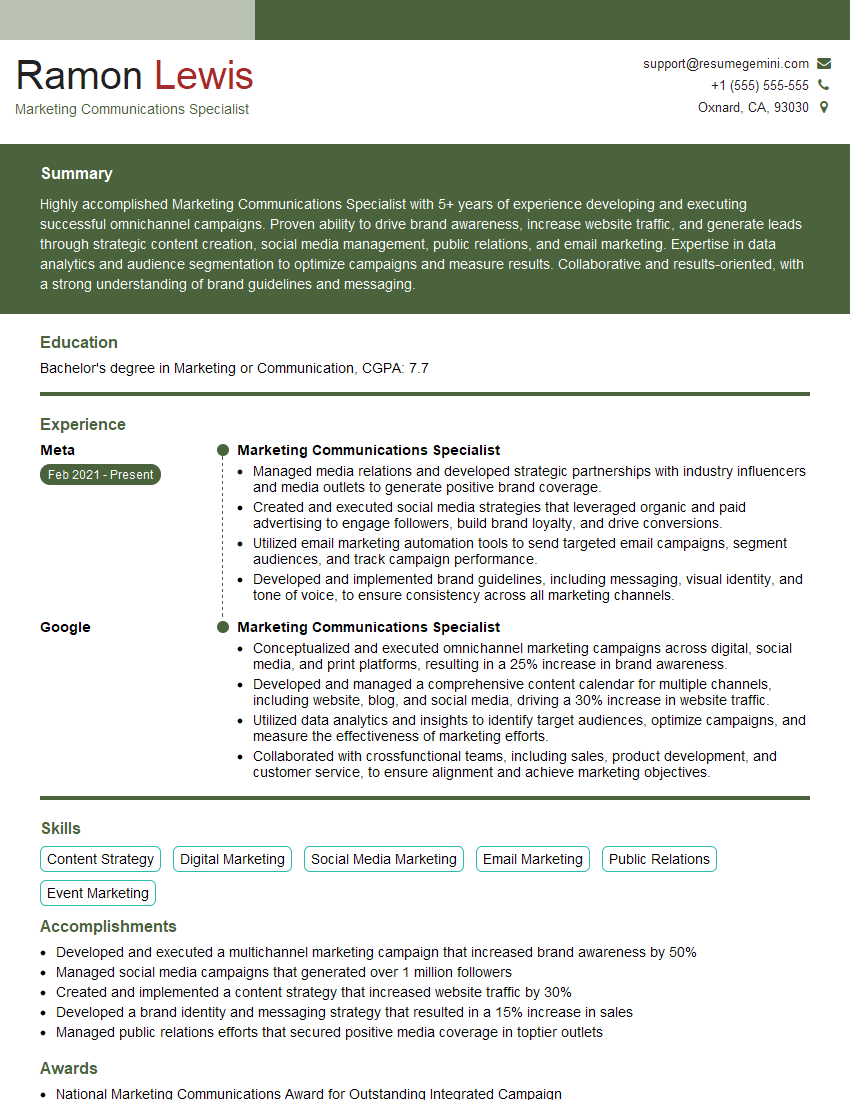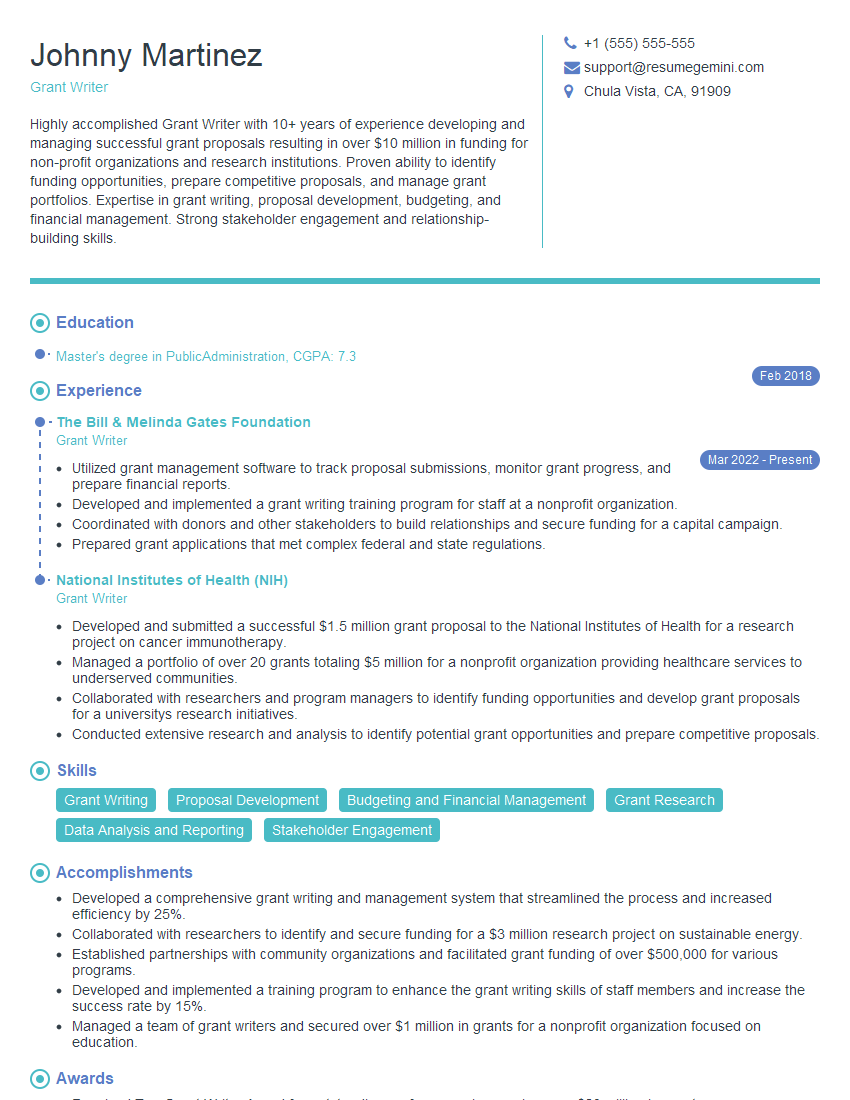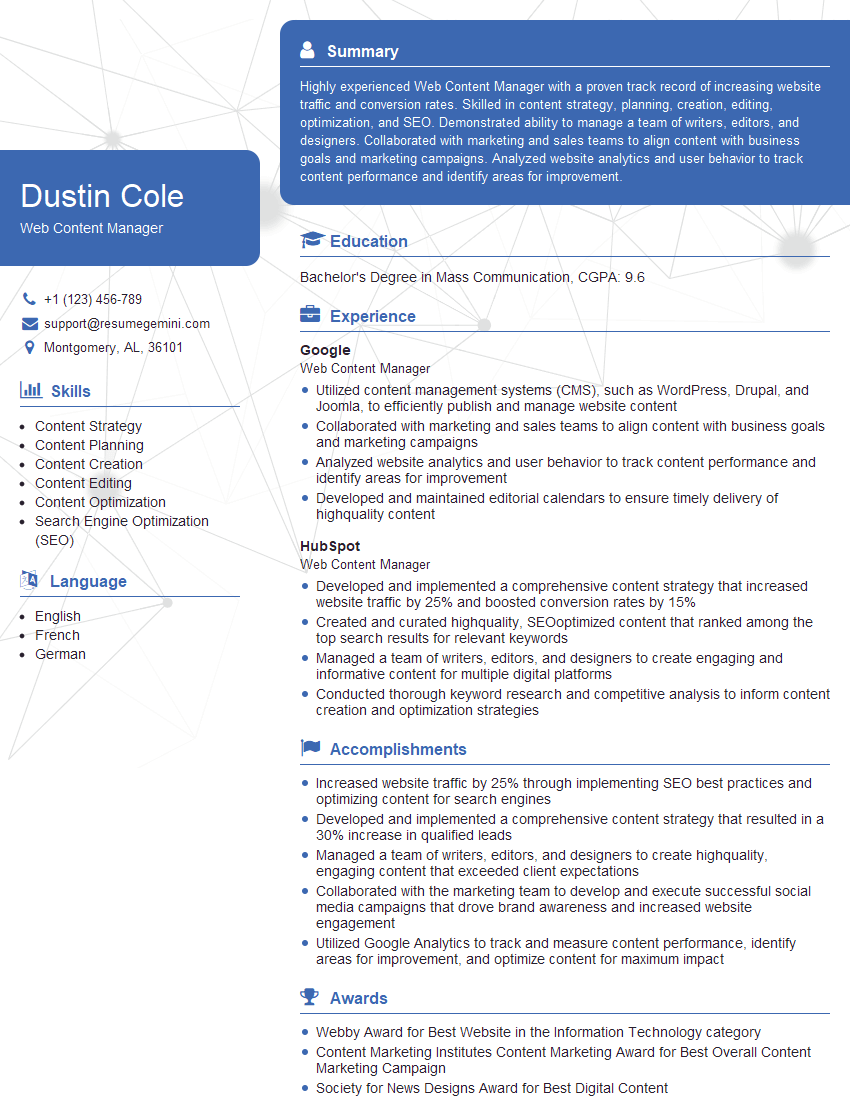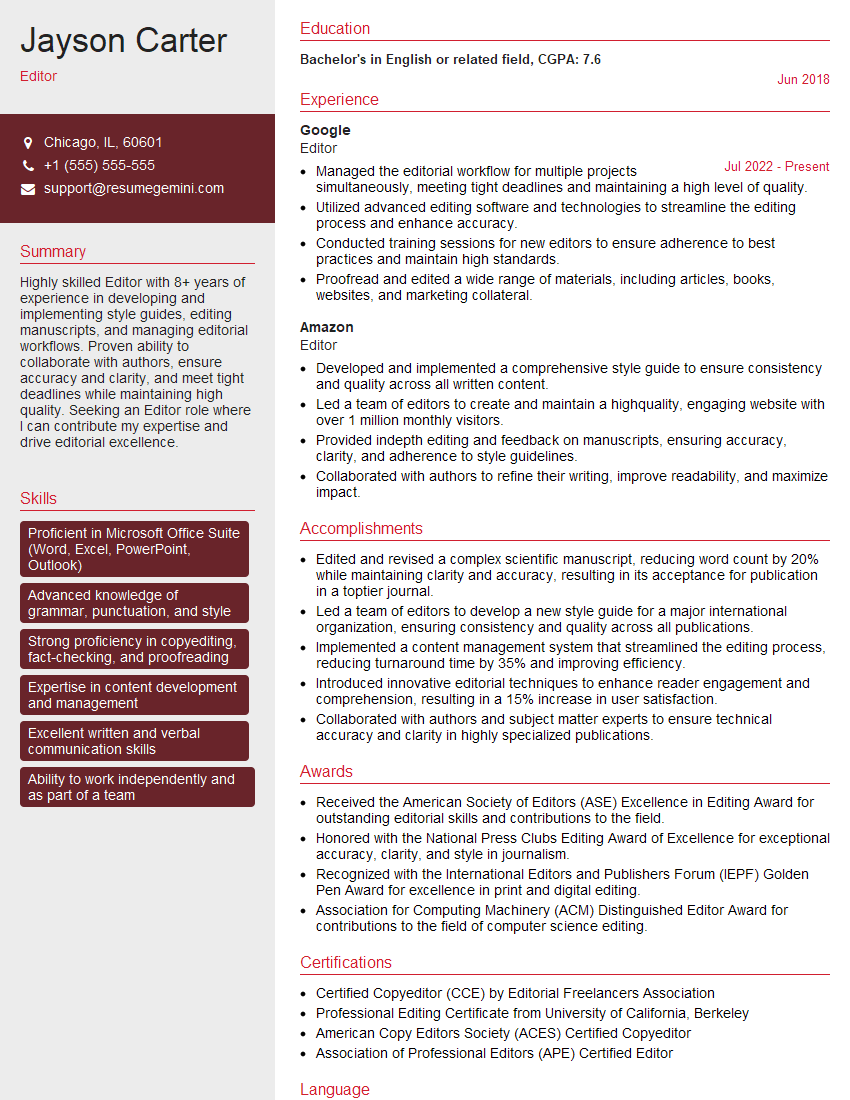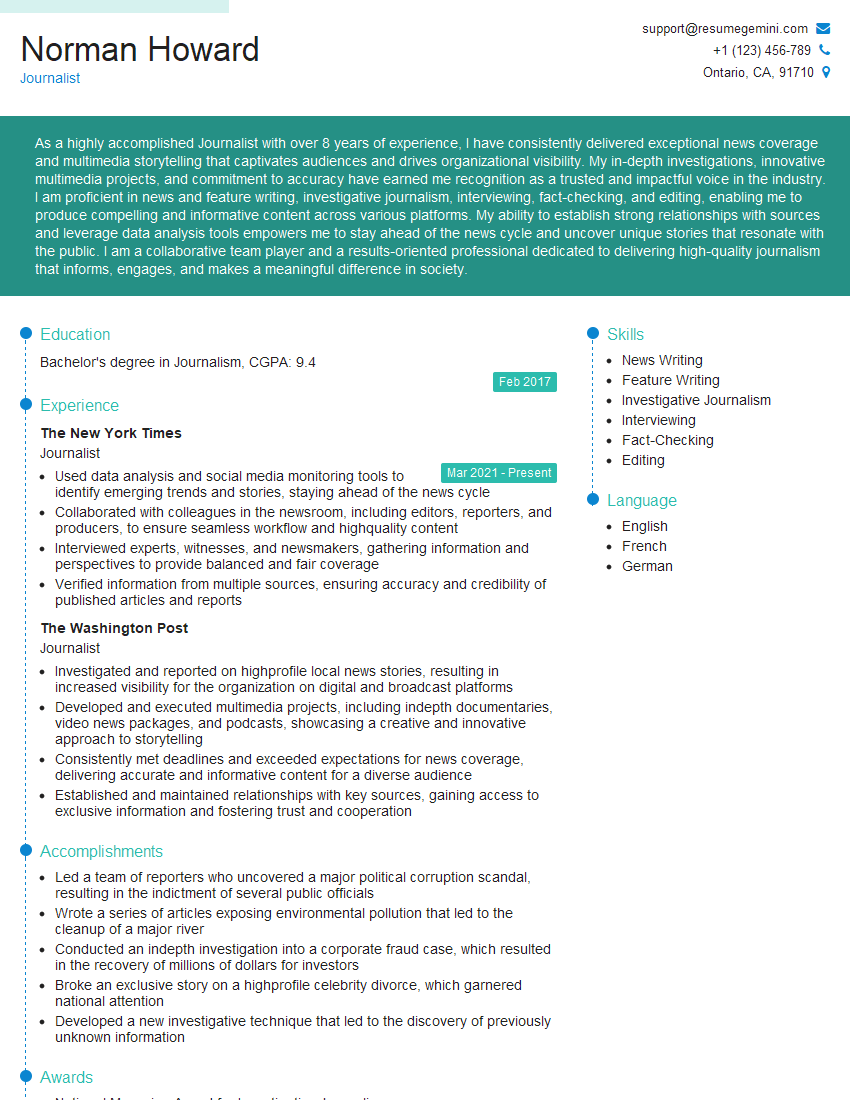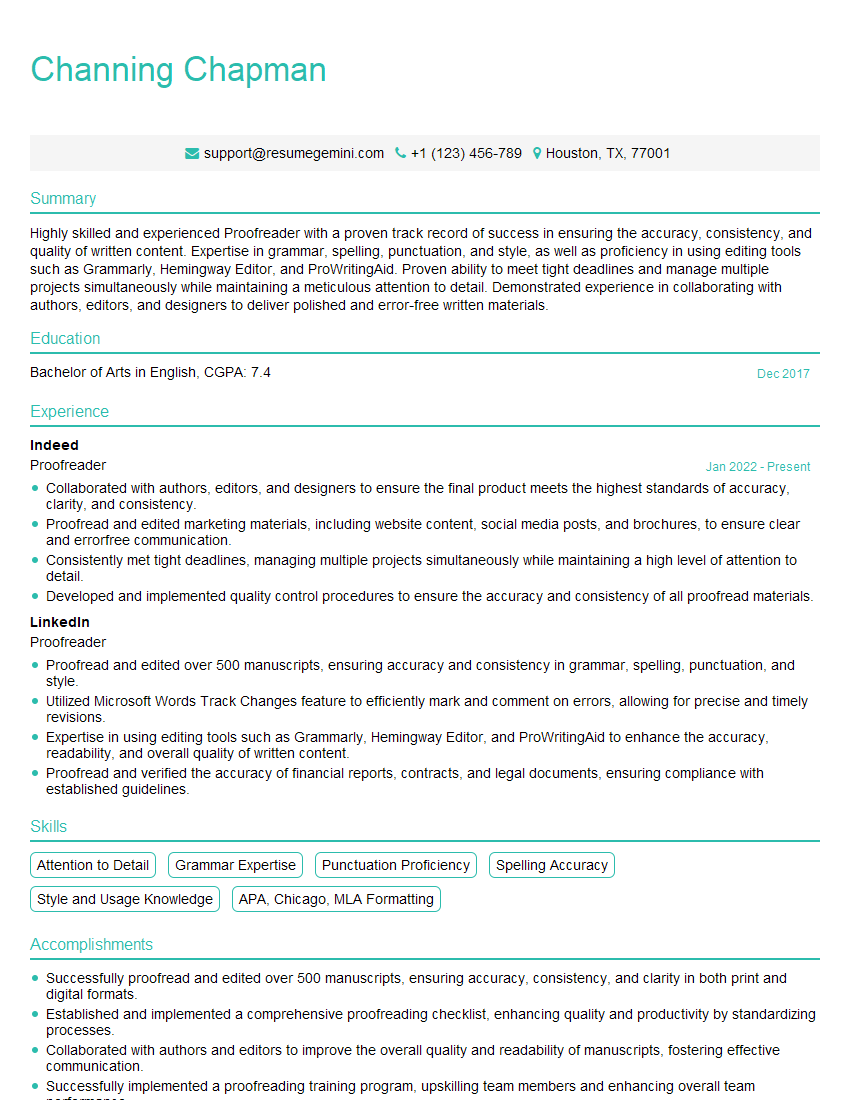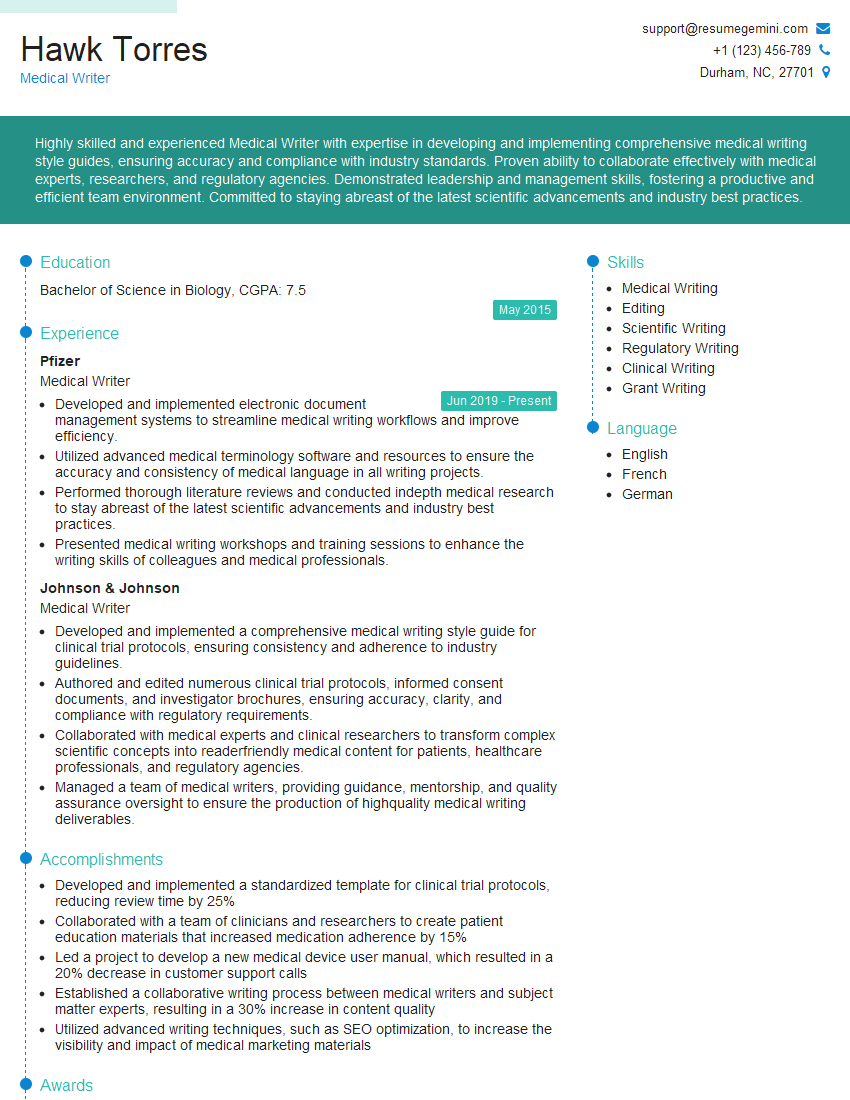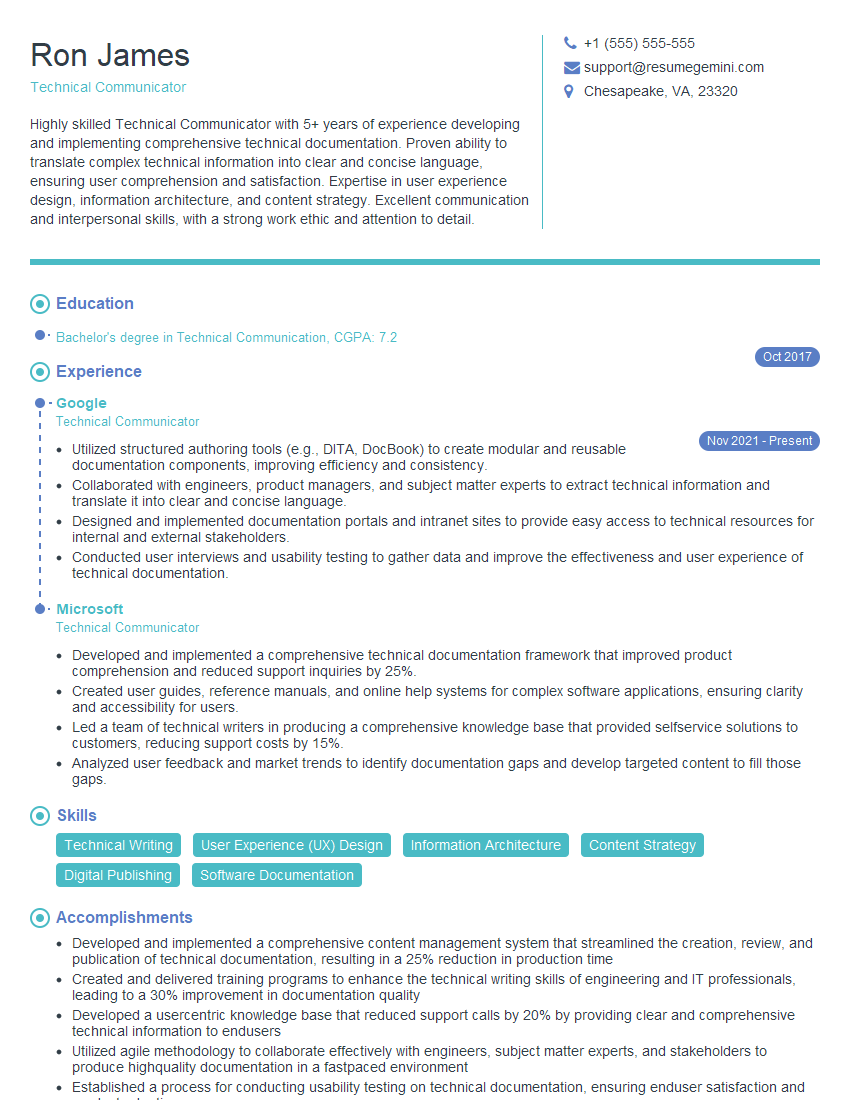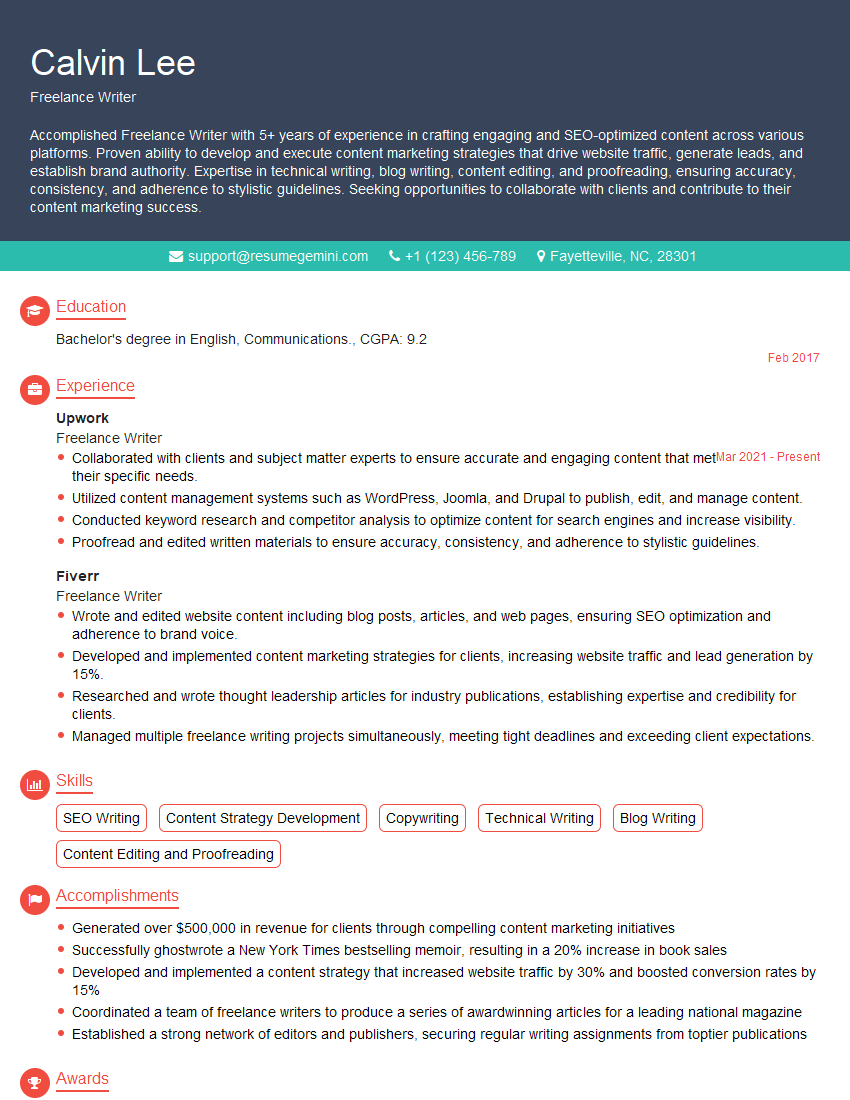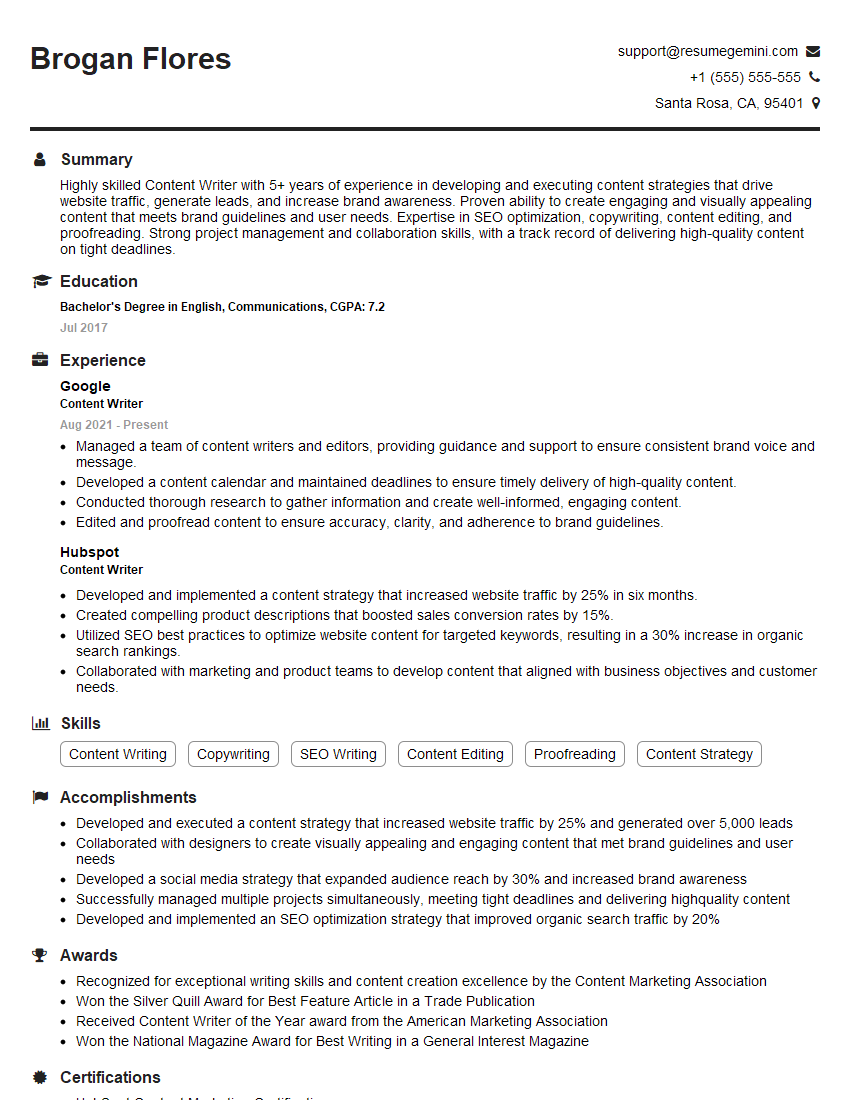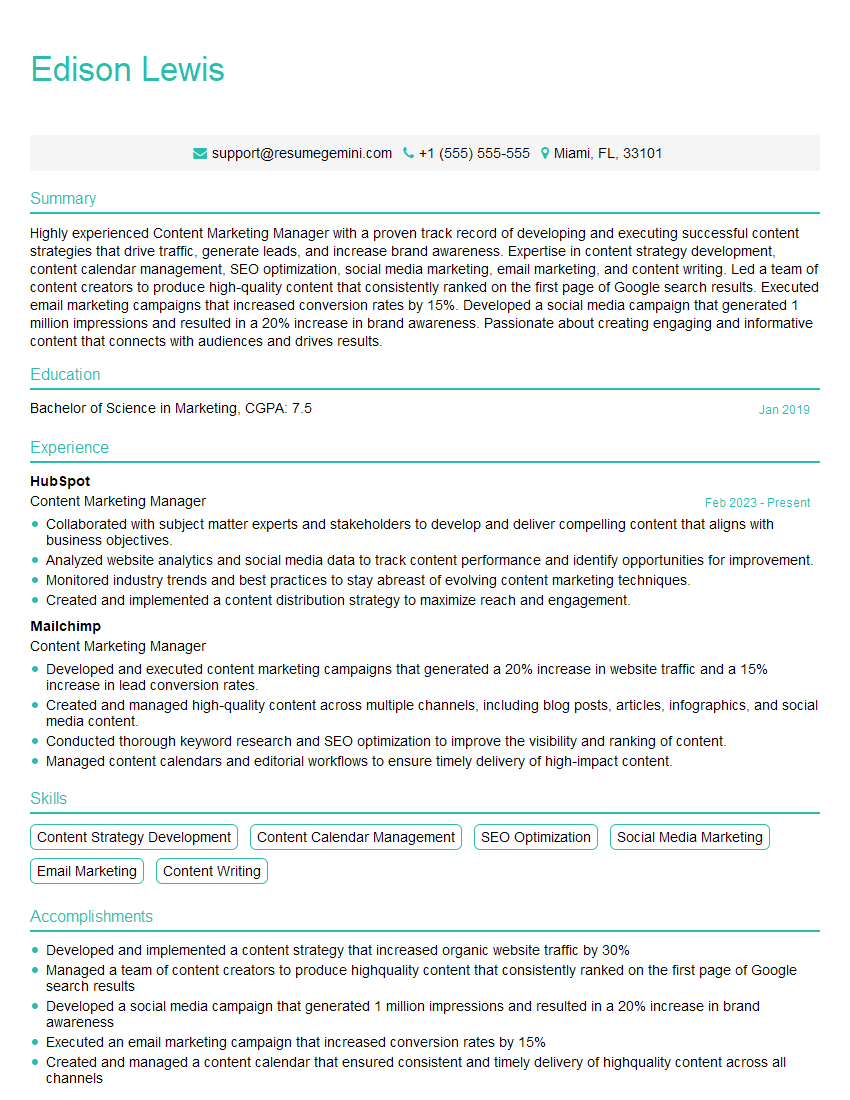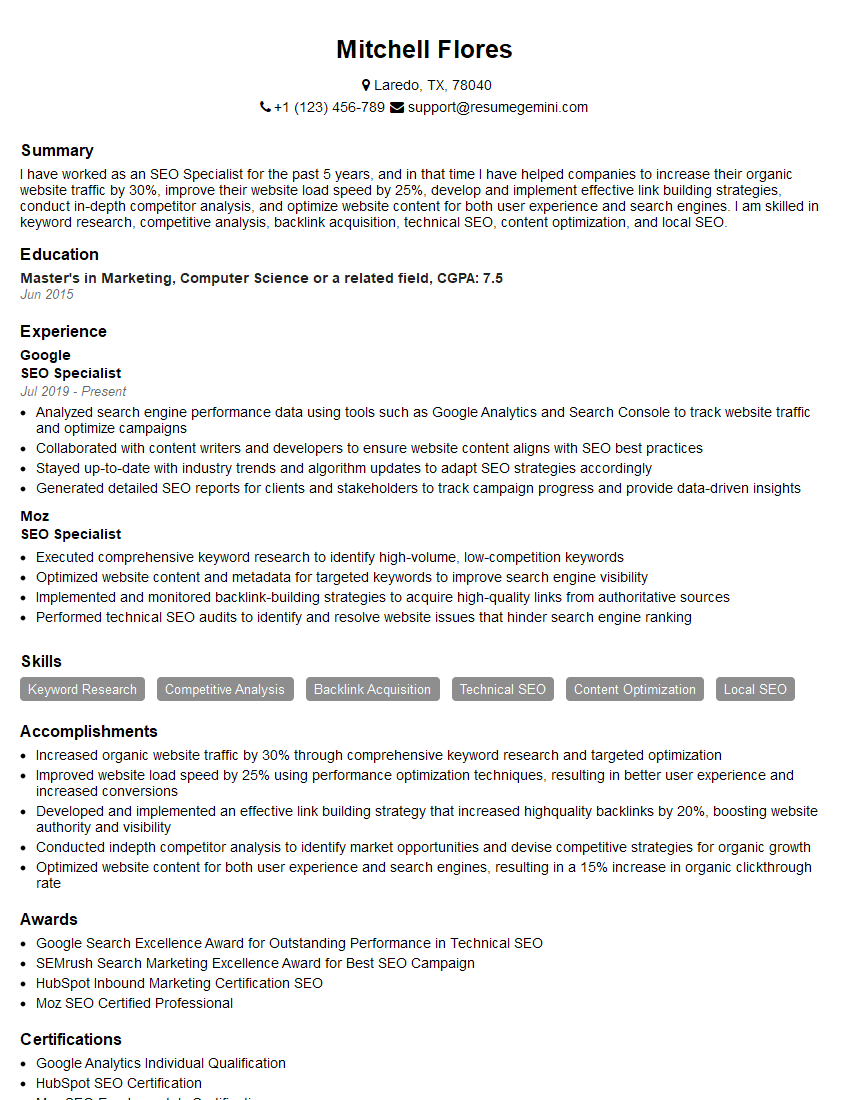Cracking a skill-specific interview, like one for Writing for Multiple Audiences, requires understanding the nuances of the role. In this blog, we present the questions you’re most likely to encounter, along with insights into how to answer them effectively. Let’s ensure you’re ready to make a strong impression.
Questions Asked in Writing for Multiple Audiences Interview
Q 1. Explain your process for adapting writing style for different audiences.
Adapting writing style for diverse audiences is a crucial skill. My process begins with a deep understanding of each audience’s unique characteristics – their background knowledge, technical expertise, reading level, and preferred communication style. I then tailor my language, tone, and structure accordingly. This involves choosing the right vocabulary (avoiding jargon for non-technical audiences, for instance), structuring information logically (using concise bullet points for busy readers, or a more narrative approach for others), and employing a tone that resonates with their expectations (formal vs. informal, friendly vs. authoritative).
For example, when writing a technical report for engineers, I would use precise terminology and detailed explanations. In contrast, when writing a blog post about the same topic for a general audience, I would simplify the language, use analogies, and focus on the overall impact rather than minute details. I use a checklist to ensure each piece aligns with the target audience’s needs.
Q 2. How do you identify the key characteristics of your target audiences?
Identifying target audience characteristics is paramount. I employ a multi-pronged approach:
- Audience Research: This involves gathering data through surveys, interviews, focus groups, and analyzing existing reader demographics and engagement data.
- Persona Development: I create detailed profiles of representative audience members, outlining their age, education level, professional background, interests, and communication preferences. This gives a ‘face’ to the audience.
- Content Analysis: Examining similar content that has resonated well with the target audience helps to understand their preferences and expectations.
- Client Collaboration: Working closely with clients to understand their goals and their vision of the audience is essential.
For example, when writing marketing materials for a new software, I would create personas representing potential users (e.g., a small business owner, a large corporation’s IT department) and tailor the language and features highlighted to match their specific needs.
Q 3. Describe a time you had to simplify complex information for a non-technical audience.
I once had to explain a complex algorithm used in financial modeling to a board of directors with limited technical backgrounds. Instead of using technical terms and mathematical formulas, I focused on explaining the core function of the algorithm using relatable analogies. I used simple examples from everyday life, such as comparing the algorithm’s predictive capabilities to forecasting the weather or predicting stock market movements. I also used visuals like charts and graphs to visually illustrate the algorithm’s process and outcomes. This approach ensured the board members understood the essence of the algorithm without getting bogged down in technicalities, enabling informed decision-making.
Q 4. How do you ensure consistency of message across multiple platforms and audiences?
Maintaining message consistency across multiple platforms and audiences requires a well-defined communication strategy. This involves developing a central message that can be adapted for different contexts, rather than creating entirely separate messages. I use a style guide, templates, and brand guidelines to ensure consistency in tone, style, and visual elements. Key message points are identified upfront and adapted, rather than re-invented, for each platform. This ensures the overall brand identity and core message remain coherent despite the varied formats and audiences.
For example, a social media post summarizing a complex whitepaper would maintain the key themes and takeaways while simplifying the language and shortening the length. A consistent brand voice and visual identity are maintained throughout.
Q 5. What strategies do you use to tailor your writing tone and style to specific audiences?
Tailoring tone and style involves understanding the nuances of each audience. For formal audiences, I use precise language, a professional tone, and a structured format. For informal audiences, I use a more conversational tone, shorter sentences, and relatable examples. Consider the context: a legal document demands formality, while a company newsletter allows a friendly, informal style. The ‘you’ versus ‘we’ perspective also influences tone – focusing on the reader’s benefits when appropriate.
For example, a report for investors would employ a formal, results-oriented tone. An internal memo to colleagues, on the other hand, could be more informal and conversational.
Q 6. How do you incorporate visual aids to enhance communication with diverse audiences?
Visual aids are invaluable in enhancing communication across diverse audiences. They simplify complex information, cater to different learning styles, and make content more engaging. I utilize a variety of visual elements depending on the audience and content: charts and graphs to represent data effectively; infographics to present complex information concisely; images and videos to illustrate concepts; icons and illustrations to enhance readability; and animations to explain processes dynamically.
For instance, while writing about climate change for a younger audience, I might use colorful illustrations and short animated videos, whereas a scientific report on the same topic would benefit from detailed charts and graphs showing specific data sets.
Q 7. How do you handle conflicting feedback from different stakeholders regarding content?
Handling conflicting feedback requires diplomatic and collaborative skills. I begin by actively listening to each stakeholder’s concerns and understanding their perspectives. Then, I analyze the feedback to identify common threads and areas of disagreement. Where possible, I try to find compromises that address the major concerns of all stakeholders without sacrificing the core message or the clarity of the content. I prioritize feedback based on the stakeholder’s authority and expertise, and clearly document all decisions made regarding feedback resolution.
If compromises aren’t possible, I may need to escalate the issue to senior management for final decision-making. Open communication and transparency are key in navigating these situations. Documenting all feedback and decisions helps maintain accountability and avoid future conflicts.
Q 8. Describe your experience writing for both internal and external audiences.
Writing for internal and external audiences requires a nuanced understanding of their respective needs and communication styles. Internal audiences, such as colleagues or employees, generally share a common organizational context and understanding of jargon. External audiences, including clients, the public, or investors, require more accessible and broadly appealing communication. My experience spans both, from crafting internal memos explaining complex technical processes to developing marketing materials for public consumption that clearly articulate product benefits.
For instance, in my previous role, I wrote detailed technical documentation for our internal software development team, using specialized terminology and focusing on technical specifications. Simultaneously, I created engaging blog posts and social media content explaining the same software’s features and benefits to potential clients, simplifying complex information into easily digestible pieces.
Q 9. How do you measure the effectiveness of your writing across different audiences?
Measuring the effectiveness of writing across different audiences involves employing a multi-faceted approach. For internal audiences, metrics might include the speed of task completion after receiving instructions, feedback surveys on clarity and helpfulness, or the reduction in errors due to clear communication. For external audiences, measurable success hinges on quantifiable outcomes like website traffic and engagement (time spent on page, bounce rate), conversion rates (e.g., sign-ups, sales), social media reach and interaction, and customer satisfaction scores from surveys or reviews.
Qualitative data is also crucial. This can include informal feedback, focus group discussions, interviews, or analyzing comments and social media responses to gauge audience perception and comprehension of the message.
Q 10. Give an example of how you’ve used data to inform your writing for a specific audience.
In a recent project, I used website analytics to inform the content of a marketing email campaign targeted at small business owners. The analytics showed that a significant portion of our website traffic came from users searching for keywords related to ‘cost-effective marketing solutions’. This data directly informed the email’s content; instead of focusing solely on our product’s features, we highlighted its affordability and return on investment (ROI), using specific case studies and quantifiable results to support our claims. The email resulted in a 20% increase in sign-ups compared to previous campaigns, demonstrating the value of data-driven writing.
Q 11. How do you ensure your writing is inclusive and avoids bias?
Ensuring inclusive and bias-free writing requires conscious effort and a commitment to diverse representation. This begins with mindful language choices, avoiding gendered terms, stereotypes, and assumptions about race, ethnicity, age, ability, or sexual orientation. Using inclusive language such as ‘they/them’ as a singular pronoun, or being mindful to use diverse examples when mentioning people or groups is essential. Active review and editing are also critical, involving colleagues with diverse backgrounds and perspectives to check for unconscious biases.
For example, instead of using phrases like ‘manpower’ or ‘chairman,’ I prefer more inclusive terms like ‘workforce’ or ‘chairperson’ (or simply ‘chair’). I also strive for balanced representation in examples and case studies, ensuring a diversity of voices and perspectives are reflected.
Q 12. Explain your understanding of accessibility guidelines for diverse audiences.
Accessibility guidelines are vital for ensuring that communication reaches the widest possible audience, particularly those with disabilities. These guidelines, often based on WCAG (Web Content Accessibility Guidelines), encompass various aspects, including:
- Text Alternatives: Providing alt text for images so screen readers can describe them to visually impaired users.
- Captioning and Transcription: Adding captions to videos and transcribing audio content for hearing-impaired users.
- Clear and Simple Language: Using plain language, avoiding jargon, and structuring text for easy readability.
- Sufficient Color Contrast: Ensuring sufficient contrast between text and background colors to improve readability for users with low vision.
- Keyboard Navigation: Making sure all content is accessible using only a keyboard, vital for users with motor impairments.
Adhering to these guidelines ensures that information is usable by everyone, regardless of ability.
Q 13. How do you approach writing for audiences with varying levels of technical expertise?
Adapting writing style for varying levels of technical expertise involves careful consideration of the audience’s prior knowledge and understanding. When writing for a technical audience, I can incorporate technical jargon and detailed explanations without simplification. However, when addressing a less technical audience, I simplify complex concepts, using analogies, metaphors, and visual aids to illustrate key points. I avoid jargon or define it clearly if it must be used. I also tailor the level of detail to the audience’s needs—a technical report will be far more detailed than a summary for non-technical stakeholders.
For example, when explaining a new software feature to developers, I’d delve into the underlying code architecture and algorithms. However, when explaining the same feature to end-users, I’d focus on the benefits and how to use it, omitting unnecessary technical details.
Q 14. Describe your experience adapting your writing style for different media formats (e.g., email, blog, report).
Adapting writing style for different media formats is crucial for effective communication. Emails prioritize brevity and clarity, focusing on a single, concise message and a clear call to action. Blogs allow for more conversational and engaging language, often incorporating storytelling, visuals, and internal links. Reports require a formal, structured approach, employing headings, subheadings, data visualization, and formal citations. Each format demands a different approach to tone, length, and style.
For instance, a blog post might use a narrative style, while an email might adopt a direct and action-oriented tone. A formal report might utilize tables and charts to present complex data, whereas a blog post would opt for simpler visual representations.
Q 15. How do you prioritize information when writing for audiences with limited attention spans?
Prioritizing information for audiences with short attention spans requires a laser focus on clarity and impact. Think of it like crafting a compelling movie trailer – you need to hook them immediately and deliver the most crucial information upfront.
- Inversion Pyramid Structure: Begin with the most important information. The key takeaway should be in the first paragraph or even the first sentence. Then, provide supporting details in descending order of importance.
- Concise Language: Avoid jargon, complex sentences, and unnecessary words. Use strong verbs and active voice to make your writing dynamic and easy to digest.
- Visual Hierarchy: Employ headings, subheadings, bullet points, and visuals (images, charts, infographics) to break up large blocks of text and guide the reader’s eye. White space is your friend!
- Scannability: Make it easy for readers to skim and quickly grasp the main points. Bold keywords, use clear signposting, and incorporate visual cues.
For example, instead of writing a lengthy explanation of a product’s features, start with a concise benefit statement, such as “Boost your productivity by 20% with our new software.” Then, follow with brief descriptions of the key features that support this benefit.
Career Expert Tips:
- Ace those interviews! Prepare effectively by reviewing the Top 50 Most Common Interview Questions on ResumeGemini.
- Navigate your job search with confidence! Explore a wide range of Career Tips on ResumeGemini. Learn about common challenges and recommendations to overcome them.
- Craft the perfect resume! Master the Art of Resume Writing with ResumeGemini’s guide. Showcase your unique qualifications and achievements effectively.
- Don’t miss out on holiday savings! Build your dream resume with ResumeGemini’s ATS optimized templates.
Q 16. How do you manage multiple writing projects with different deadlines and audience requirements?
Juggling multiple writing projects with varying deadlines and audience needs demands a robust organizational system. I rely on a combination of project management tools and strategic planning.
- Prioritization Matrix: I use a matrix to rank projects based on urgency and importance (Eisenhower Matrix is a great example). This helps me focus on the most critical tasks first.
- Detailed Project Briefs: For each project, I create a detailed brief outlining the target audience, key messages, deadlines, and deliverables. This keeps me focused and on track.
- Time Blocking: I dedicate specific blocks of time to each project, minimizing context switching and maximizing focus. This is particularly useful when dealing with projects that require different writing styles or tones.
- Project Management Software: Tools like Asana, Trello, or Monday.com help me track progress, manage deadlines, and collaborate with editors and stakeholders effectively.
For instance, if I’m working on a technical white paper and a blog post simultaneously, I’ll dedicate mornings to the white paper (requiring more focused, technical writing) and afternoons to the blog post (allowing for more creative freedom). This structured approach prevents burnout and ensures timely completion of all projects.
Q 17. What tools or techniques do you use to ensure the clarity and accuracy of your writing?
Clarity and accuracy are paramount. I employ several tools and techniques to ensure my writing meets the highest standards.
- Multiple Readings and Revisions: I always review my work multiple times, checking for clarity, consistency, grammar, and factual accuracy. A fresh pair of eyes is often helpful after a break.
- Style Guides and Dictionaries: Adhering to style guides (e.g., AP Stylebook, Chicago Manual of Style) ensures consistency and professionalism. Dictionaries and thesauruses help me choose the most precise words.
- Grammar and Spell Checkers: While not foolproof, tools like Grammarly or ProWritingAid can catch errors I might miss.
- Fact-Checking and Verification: I meticulously verify facts and figures using reliable sources. This is especially crucial when writing on technical or scientific topics.
For example, before publishing any article that includes statistics, I make sure to cross-reference the data from multiple credible sources to ensure accuracy. This meticulous approach builds trust with my audience.
Q 18. How do you incorporate feedback from editors and other stakeholders into your writing process?
Incorporating feedback is a crucial part of my writing process. I view feedback not as criticism, but as an opportunity for improvement.
- Active Listening and Engagement: I carefully read and consider all feedback, actively seeking to understand the editor’s or stakeholder’s perspective. I ask clarifying questions if needed.
- Organized Tracking: I use a system (comments in the document, a separate feedback document) to track all comments and revisions. This ensures I don’t miss anything.
- Iterative Revision: I revise my writing in iterations, addressing each piece of feedback systematically. This avoids overwhelming myself and allows for incremental improvements.
- Professionalism and Respect: I maintain a professional and respectful tone in my communication with editors and stakeholders, even when disagreeing on a point.
For instance, if an editor suggests shortening a paragraph, I don’t just delete sentences randomly. I carefully analyze the paragraph, identify the core message, and rewrite it concisely while retaining the original meaning.
Q 19. How do you ensure your writing is SEO-optimized for different target audiences?
SEO optimization for diverse audiences requires a nuanced approach. It’s not just about stuffing keywords; it’s about understanding what each audience searches for and tailoring your content accordingly.
- Keyword Research: I use tools like SEMrush, Ahrefs, or Google Keyword Planner to identify relevant keywords for each target audience. Different audiences will use different terminology.
- Audience-Specific Content: The content itself needs to address the specific needs and interests of each target audience. A technical audience will require different information than a general audience.
- On-Page Optimization: This includes optimizing title tags, meta descriptions, headings, and image alt text with relevant keywords. However, keyword stuffing is detrimental to readability and user experience.
- Content Clusters and Topic Clusters: Organize content around core topics and create interconnected pages to improve SEO and user experience.
For example, when writing about a software program, I would use technical keywords like “API integration” for developers, while focusing on user-friendly terms like “easy to use” for a general audience.
Q 20. Describe a time you had to revise your writing based on audience feedback.
I once wrote a blog post about a complex financial product. My initial draft was heavily focused on technical details and industry jargon. However, feedback from the marketing team highlighted that the target audience (average consumers) would find this confusing and inaccessible.
Based on their feedback, I completely revised the post. I replaced technical terms with simpler language, used analogies and real-world examples to explain complex concepts, and restructured the content to be more scannable and engaging. The revised post performed significantly better, achieving higher engagement and conversions.
Q 21. How do you conduct audience research to inform your writing strategy?
Conducting thorough audience research is fundamental to effective writing. It allows me to tailor my content to resonate with my readers and achieve my communication goals.
- Surveys and Questionnaires: These help gather quantitative and qualitative data about the audience’s demographics, needs, interests, and knowledge levels.
- Interviews and Focus Groups: These provide deeper insights into the audience’s perspectives and motivations. They allow for more nuanced understanding of their needs.
- Analyzing Existing Data: This could include reviewing website analytics, social media engagement, and customer feedback to understand audience behavior and preferences.
- Persona Development: Creating detailed buyer personas helps to visualize the ideal reader and tailor the content to their specific characteristics and needs.
For instance, before writing a series of articles about sustainable living, I conducted surveys to understand readers’ existing knowledge, their concerns about environmental issues, and their willingness to adopt sustainable practices. This research helped me tailor the content to effectively engage the target audience and guide them toward sustainable choices.
Q 22. What are some common challenges you encounter when writing for multiple audiences?
Writing for multiple audiences presents a fascinating challenge: finding the common ground while acknowledging the unique needs and perspectives of each group. The primary difficulty lies in balancing the need for clarity and conciseness with the requirement of tailoring the message for diverse levels of understanding, technical expertise, and interests.
- Differing levels of technical expertise: Explaining complex concepts to both experts and novices requires careful word choice and potentially multiple explanations. For example, a software manual needs a different approach for developers than for end-users.
- Varying interests and priorities: Different audiences will have different reasons for engaging with your content. A marketing email for CEOs will focus on ROI, while an email to potential customers might emphasize ease of use.
- Conflicting communication styles: Formal vs. informal, direct vs. indirect – aligning different communication preferences within a single piece of content is a delicate balancing act.
For instance, imagine creating a website for a medical clinic. You’d need different content for patients (explaining treatments in simple terms), doctors (providing detailed research information), and insurance companies (focusing on billing and compliance).
Q 23. How do you maintain your credibility and professionalism when addressing diverse audiences?
Maintaining credibility and professionalism across diverse audiences requires a nuanced approach emphasizing clarity, accuracy, and ethical communication. It’s crucial to avoid making generalizations or using language that could be considered offensive or insensitive.
- Thorough research and fact-checking: Accurate information builds trust and demonstrates expertise. This is crucial regardless of the audience.
- Consistent tone and style: Maintaining a professional tone is vital. While the level of formality might adjust for different audiences, the overall professionalism should remain constant.
- Transparency and disclosure: If using data or opinions from specific sources, clearly state them. This enhances transparency and accountability.
- Audience-appropriate language: Adjusting the vocabulary and complexity of language is essential to cater to differing levels of expertise. Avoid jargon whenever possible, or provide clear explanations when necessary.
For example, when writing about financial matters, one might use simpler language for a general audience, but include more specific financial terminology for an audience of financial professionals. However, the accuracy and ethical integrity of the information presented remains constant.
Q 24. How do you navigate cultural differences when writing for global audiences?
Navigating cultural differences when writing for global audiences is critical for effective communication and avoiding misunderstandings. It requires sensitivity, awareness, and a commitment to inclusive language.
- Language translation and localization: Direct translation is often insufficient. Localization considers cultural nuances, idioms, and preferred communication styles. This goes beyond simple word-for-word translation; it adapts the content for the target culture.
- Cultural sensitivity in imagery and design: Images and colors carry cultural significance. What is considered positive in one culture may be negative in another. Careful consideration is vital.
- Understanding different communication styles: Some cultures value direct communication; others prefer indirect approaches. Awareness of these differences prevents misinterpretations.
- Respect for local customs and norms: Content should always be respectful of local customs, religions, and beliefs. Avoid using stereotypes or making assumptions about any cultural group.
For instance, a marketing campaign that uses vibrant colors and playful imagery in one region might need a more subdued approach in another, depending on local cultural norms and preferences.
Q 25. Describe your experience working with content management systems (CMS) for multi-audience content.
Content Management Systems (CMS) are invaluable tools for managing multi-audience content. They allow for efficient organization, version control, and targeted delivery.
- Content segmentation and tagging: CMSs permit categorizing and tagging content based on audience segments. This allows for customized delivery, ensuring the right content reaches the right audience. For example, tags like
<audience:technical>and<audience:general>can help to filter content. - Personalized user experiences: Some CMSs offer sophisticated personalization features. Based on user data, these systems can automatically display relevant content, creating a targeted experience.
- Workflow and collaboration tools: CMSs enhance team collaboration. Multiple authors can contribute to a project, with version control and approval workflows ensuring consistency and quality.
- Multilingual support: Many CMSs support multiple languages, facilitating the creation and management of localized content for global audiences.
I’ve used platforms like WordPress and Drupal extensively, leveraging their capabilities to create and manage content for various client audiences, streamlining workflows and significantly improving the overall efficiency of content production and distribution.
Q 26. How do you use A/B testing to optimize content for different audiences?
A/B testing is a crucial aspect of optimizing content for different audiences. It allows for data-driven decision-making, ensuring content resonates effectively.
- Hypothesis development: Before testing, formulate specific hypotheses about what might resonate with each audience. For instance, ‘Headline A will generate higher click-through rates among younger audiences than Headline B.’
- Test design: Create different versions of the content (A and B variations), focusing on key elements like headlines, imagery, and calls to action.
- Controlled experiment: Expose each audience segment to different versions of the content. Ensure similar user demographics are distributed evenly.
- Data analysis and iteration: Analyze the results, focusing on key metrics like click-through rates, conversion rates, and time spent on page. Based on the data, refine the content to improve performance.
For example, I once A/B tested two different email subject lines targeting different customer segments. One subject line emphasized a discount, while the other highlighted time savings. The data showed that one subject line performed significantly better for one segment, while the other performed better for the second segment, demonstrating the importance of tailoring messaging.
Q 27. What are your strategies for engaging diverse audiences through storytelling?
Engaging diverse audiences through storytelling is a powerful technique. It connects with people on an emotional level, fostering understanding and building relationships.
- Authenticity and relatability: Stories need to be authentic and relatable to the target audience. Use examples and characters that resonate with their experiences and values.
- Diverse perspectives: Include diverse characters and perspectives in your stories, showcasing different backgrounds and viewpoints. Avoid stereotypes and promote inclusivity.
- Clear narrative arc: A compelling story should have a clear beginning, middle, and end, with well-defined characters and a satisfying resolution.
- Multi-sensory engagement: Engage multiple senses through vivid descriptions and imagery. The reader should be able to ‘see,’ ‘hear,’ and ‘feel’ the story.
For example, a company might use storytelling to showcase the impact of their work on different communities. One story could focus on empowering women entrepreneurs in a developing country, while another highlights the environmental sustainability initiatives within their company. By sharing diverse stories, the company connects with multiple audiences on a human level, enhancing engagement and brand loyalty.
Key Topics to Learn for Writing for Multiple Audiences Interview
- Audience Analysis: Understanding diverse reader needs, backgrounds, and communication preferences (e.g., technical vs. non-technical, executive vs. junior staff).
- Adapting Tone and Style: Tailoring your writing style to suit different audiences – formal vs. informal, persuasive vs. informative, concise vs. detailed. Practical application: Crafting a compelling cover letter for a senior management role versus a project proposal for a team.
- Message Clarity and Structure: Ensuring your message is easily understood by all audiences, regardless of their prior knowledge. This includes structuring information logically, using clear headings, and employing effective visuals.
- Content Strategy and Planning: Defining your target audience(s) and developing a communication plan to reach them effectively across various channels (e.g., email, reports, presentations).
- Feedback and Iteration: Understanding the importance of gathering feedback and revising your writing based on audience reactions and understanding. Problem-solving approach: addressing concerns about clarity or effectiveness identified through feedback.
- Ethical Considerations: Ensuring your writing is accurate, fair, and avoids bias or misrepresentation when addressing diverse audiences.
- Multi-Platform Writing: Adapting your writing style and content for different platforms (e.g., website copy, social media posts, blog articles).
Next Steps
Mastering the art of writing for multiple audiences is crucial for career advancement. It demonstrates adaptability, strong communication skills, and the ability to connect effectively with diverse stakeholders. This skill is highly sought after in today’s dynamic work environment. To boost your job prospects, focus on creating an ATS-friendly resume that showcases your abilities clearly and concisely. ResumeGemini is a trusted resource for building professional, impactful resumes tailored to your specific needs. Utilize ResumeGemini to craft a compelling resume that highlights your proficiency in writing for multiple audiences. Examples of resumes tailored to this skill set are provided to further assist you.
Explore more articles
Users Rating of Our Blogs
Share Your Experience
We value your feedback! Please rate our content and share your thoughts (optional).
What Readers Say About Our Blog
Dear Sir/Madam,
Do you want to become a vendor/supplier/service provider of Delta Air Lines, Inc.? We are looking for a reliable, innovative and fair partner for 2025/2026 series tender projects, tasks and contracts. Kindly indicate your interest by requesting a pre-qualification questionnaire. With this information, we will analyze whether you meet the minimum requirements to collaborate with us.
Best regards,
Carey Richardson
V.P. – Corporate Audit and Enterprise Risk Management
Delta Air Lines Inc
Group Procurement & Contracts Center
1030 Delta Boulevard,
Atlanta, GA 30354-1989
United States
+1(470) 982-2456
